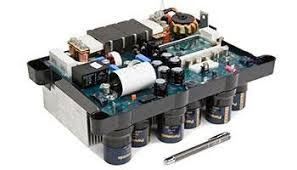Solid State Transformer
A solid-state
transformer (SST), a power electronic transformer, or electronic power
transformer is actually AC-AC converter, a type of electric power
converter that replaces a conventional transformer used in AC
electric power distribution. It is more complex than a conventional transformer
operating at utility frequency, but it can be smaller and more efficient
than a conventional transformer because it operates at high frequency.
The solid
state transformer (SSTs) are designed with different topologies based on
its application:
AC to AC buck converter:
- Transformation of the voltage level directly without any isolation transformer
- Switches must be capable of blocking full primary volatge during OFF state and conducting full secondary current during ON state.
- Difficult to control series-connected devices
- Lack of magnetic isolation
- Inability to correct load power factor
SST without a DC link:
- Transformer weight and size reduced
- Provides isolation
- No power factor improvement is possible
SST with a DC link:
- Reduced size due to a high-frequency transformer
- Power factor improvement is possible
- Multilevel converter topologies can be applied to achieve high voltage levels (e.g., 11 kV, 22 kV)
- High cost and low efficiency
- It is a three-stage topology: most popular now
SSTs that
can be widely used in microgrid applications are relatively advantageous
with respect to power quality.
Advantages
- An excellent utilization of distributed renewable energy resources and distributed energy storage devices
- Power factor control
- Fast isolation under fault conditions due to a controlled SST
- Control of both AC and DC loads can be done using the SST scheme
- Improved power quality
- DC and alternative frequency AC service options
- Integration with system monitoring and advanced distribution
- Reduced weight and size
- Elimination of hazardous liquid dielectrics
Limitations
- Multiple power conversion stages can lower the overall efficiency
- DC-link capacitors are required
- The transformer lifetime can be shorter due to storage devices









No comments:
Post a Comment